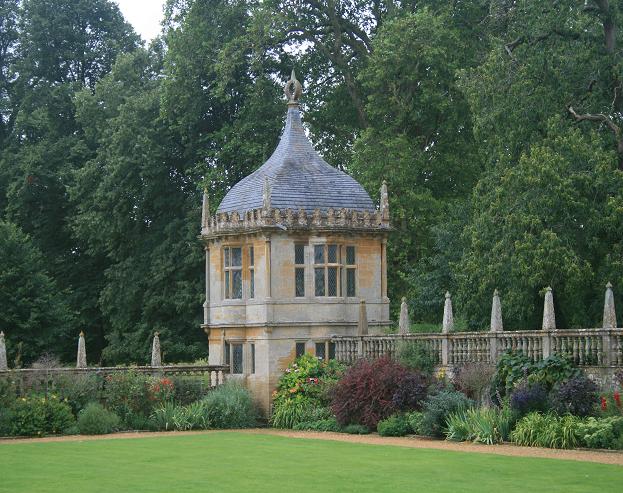 |
| One of a pair of gazebos at Montacute House (attrib. Les Mildon) |
The word ‘gazebo’ is a flippant translation from the Latin, ‘I will gaze’, and is used to describe a building or structure from which one may enjoy a view over the garden. Proper ‘gazing’, required the viewer have an elevated position, and a gazebo came to mean either a small building placed on a natural vantage point or a specially constructed two story stone or brick garden building with a viewing room on the first floor. The gazebo became an especially popular feature in Elizabethan gardens, where the buildings were often built at a corner angle within an enclosed garden in order to command the finest view out over the garden. This position also meant that the buildings themselves could be admired as a feature in their own right. A twin pair were built in the garden at Montacute House in Somerset.
 | |
|
These ornate buildings, which were also used to
entertain, trace their origins back through the banqueting houses and
wooden structures placed on the top of garden mounts (an innovation of
the Tudor garden in 16th century England), to the simple bower, either
constructed from trellis or woven saplings, so favoured in the Mediæval
garden.
 |
| One of the two gazebos at Ram Bagh in Agra that overlook the Jumna River and the garden |
Gazebos were also popular in Mughal gardens, where such structures were sometimes built in groups of four, echoing their ancestors, the four dovecotes, one in each the four corners of the quadripartite Persian garden.
 |
| Gazebo in the 'Hanging Garden of Nineveh |
Older designed landscapes from the region, for example Mesopotamia such as those made by the Assyrian kings Sennacherib (r.705-681) at Nineveh (Kuyundjik) and his predecessor Sargon II (r.722-705 BC) at Khorsabad also had garden buildings atop artificial mounts which fit the definition of a gazebos but are often called or pavilions.
Sadly, in an October 2010 report titled Saving Our Vanishing Heritage,
named Nineveh was named by the Global Heritage Fund as one of 12 sites most 'on the verge' of irreparable
destruction and loss, citing insufficient management, development
pressures and looting as primary causes.

No comments:
Post a Comment